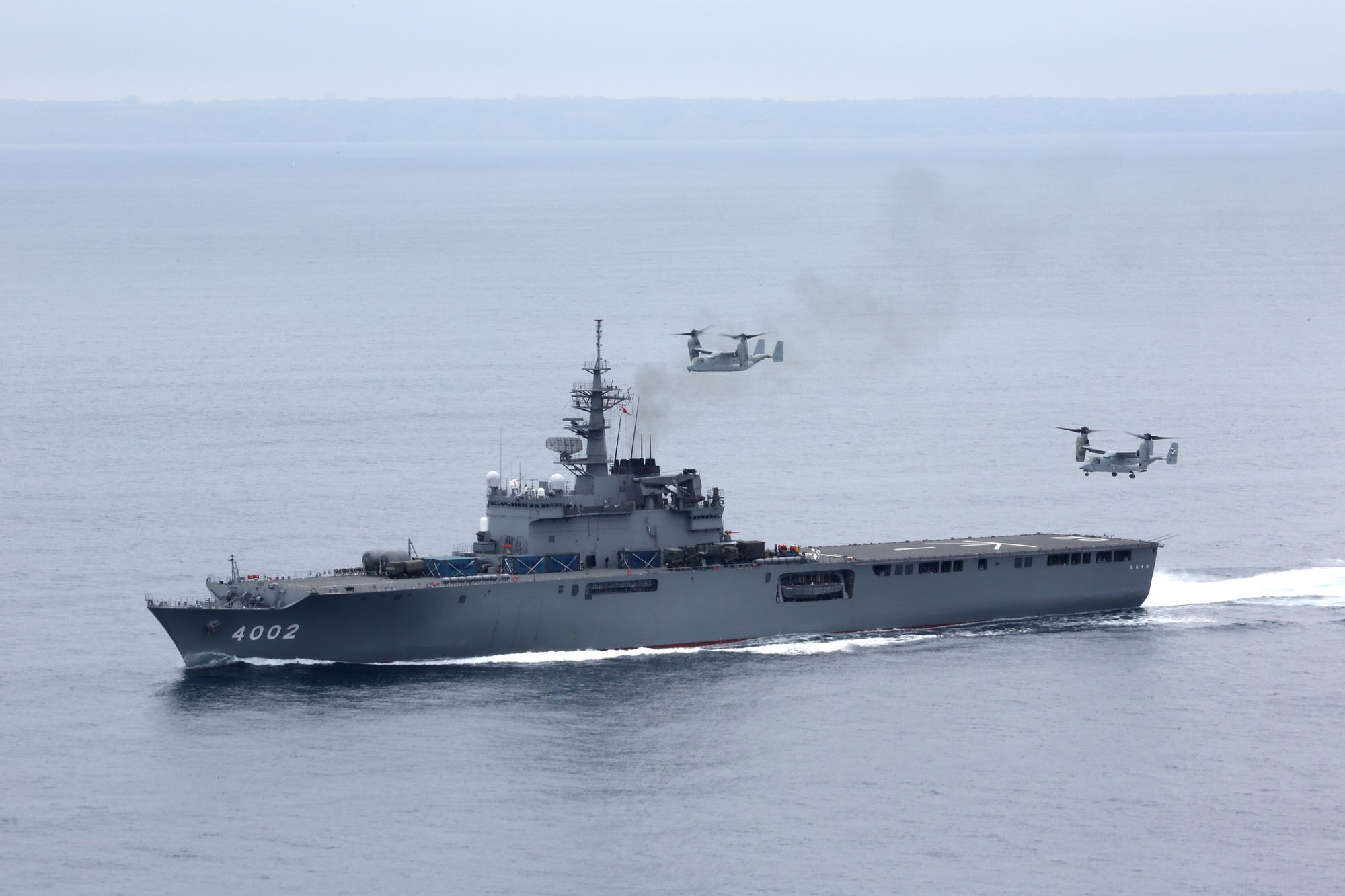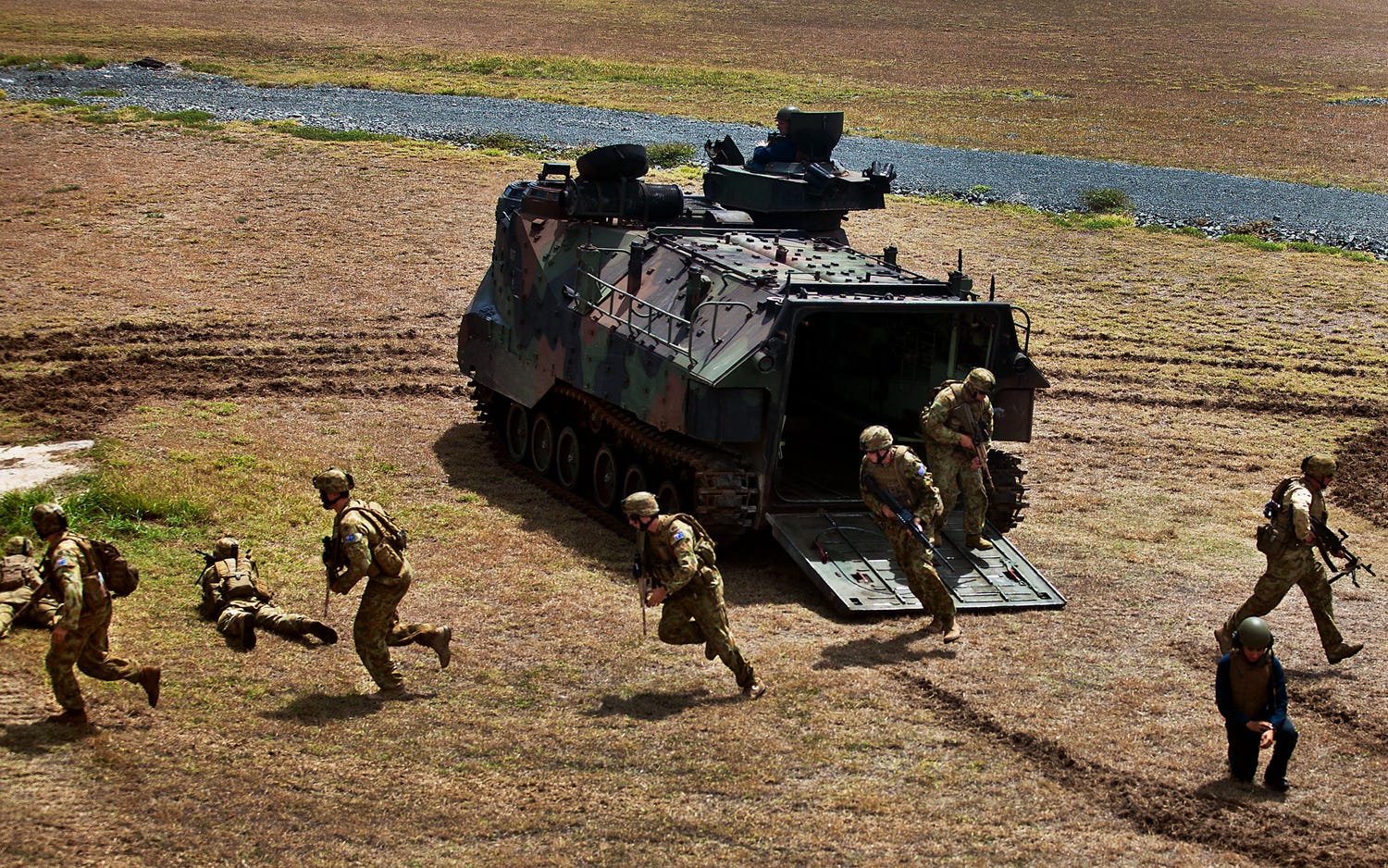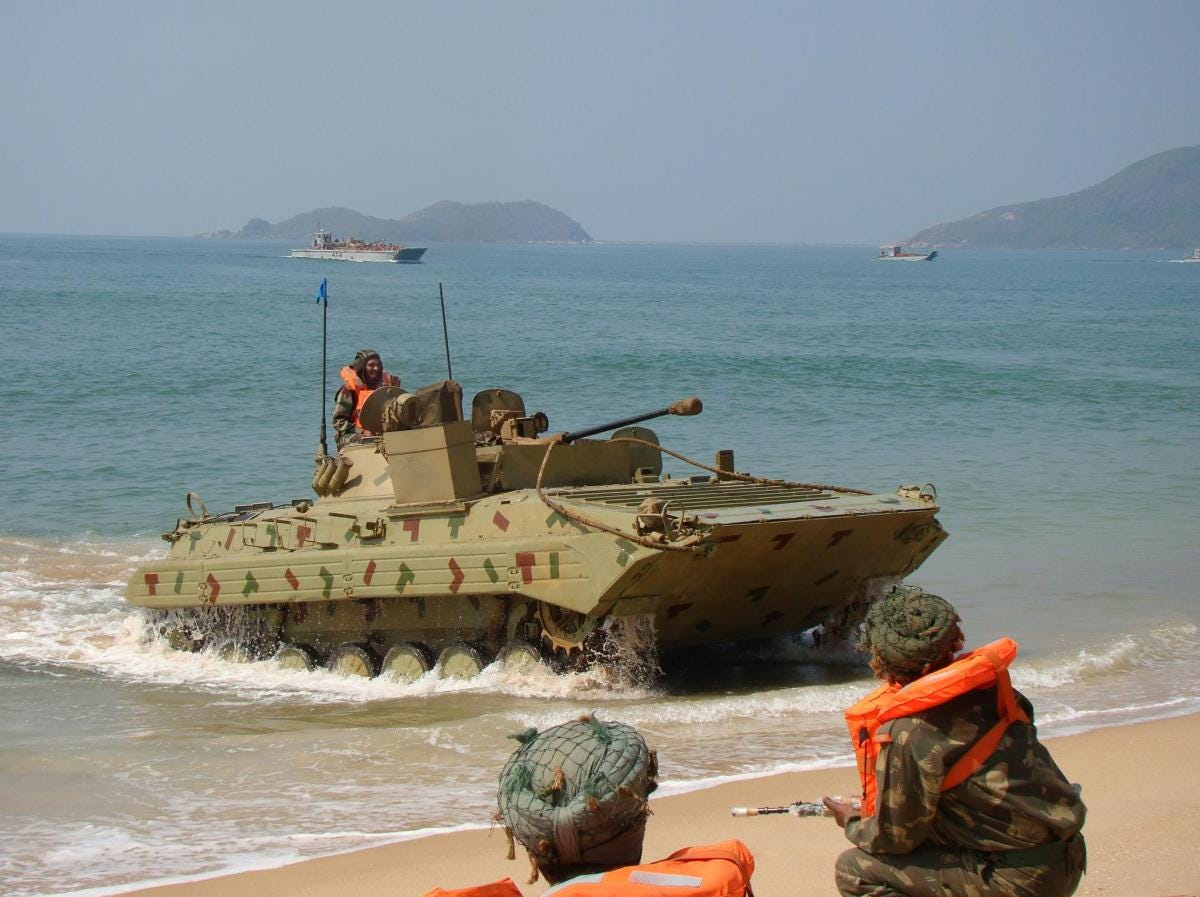To counter China, Asian militaries build up amphibious forces
Across the Pacific Rim, regional powers are creating new marine infantry units.
Fast, highly-trained and designed for military missions originating from the sea, marines are invaluable for the kinds of conflicts Asian and Pacific nations might fight in the future.
Since 2009, India, Australia and Japan have all announced the creation of seagoing infantry forces.
These units are tiny in comparison to the U.S. Marine Corps. But Asia’s regional powers are not just creating mini-marine forces of their own, they’re buying the landing ships and transport aircraft to carry troops to danger zones and—if necessary—into battle.
It’s an expensive insurance policy for a region where Pacific Ocean shipping lanes serve as economic lifelines. Losing control of these sea lanes will havedire consequences for billions of people.
But as these three countries are discovering—there’s a lot to learn when it comes to amphibious warfare.
Naval infantry have existed for thousands of years, and specialized marine units date to the 16th century Spanish Empire. But it’s Asia that spurred the creation of modern marines.
In the years before World War II, Imperial Japanese troops struggled to digest China. The country’s tough coastline—crisscrossed with river systems and water that was much too shallow for harbors—prompted Japan to invent flat-bottomed landing craft, capable of delivering ground forces directly to shore.
After the war, Japan disbanded its entire military, and passed the torch of amphibious operations to the U.S. Marines. As the world’s preeminent amphibious force, the USMC acts as a go-to expeditionary army designed to operate far beyond America’s borders.
The budding Asian marines will likely work in the same fashion, but with a more regional—and less global—focus. Many Asian nations rely on shipping lanes to sustain their economies. These lanes reach through the Straits of Malacca, the Indian Ocean and the Persian Gulf.
These lanes need security. The marines’ likely scenarios include fighting pirates, conducting peacekeeping operations and responding to natural disasters.
Asian nations are also more likely than the U.S. to use their marines on home territory. India and Japan have extensive coastlines, along with island chains near potential adversaries such as China … and Pakistan—for India.
At top—Japanese troops disembark during an exercise on San Clemente Island on June 17, 2013. U.S. Marine Corps photo. Above—an Indian BMP-2 comes ashore during an amphibious exercise. Indian Navy photo
India versus China
The Indian Army only recently become serious about amphibious warfare.
India has more than 4,600 miles of coastline and 1,200 islands. The country faces a variety of maritime security challenges, including a coastal border with arch-enemy Pakistan and the threat posed by international terrorism. In 2008, terrorists used the sea to infiltrate and attack Mumbai.
But the greatest potential threat is from China. Beijing’s economic lifeline runs from the Asian mainland to the Persian Gulf. It’s a tenuous path, and China intends to guard it with a so-called “String of Pearls.” A chain of naval bases stretching partially through the Indian Ocean.
Conflict in the Indian Ocean will put remote Indian territories, such as the Nicobar and Andaman islands, at risk. China could rush marines to bolster island defenses. If New Delhi needs to seize one of the so-called “pearls,” it will need marines.
Traditionally, India tasked the 340th Independent Infantry Brigade for amphibious operations. In 2010, it re-activated the 5,000-man 91st Infantry Brigade as a marine unit. The same year, India re-designated the 10,000-man 54th Infantry Division as an amphibious unit.
The 5th Armored Regiment—equipped with modern, Russian-designed T-90 tanks—can also call on a tank-landing ship for seagoing transport.
India doesn’t have a manpower shortage. But to move their marines from one location to another, the Indian Navy will need ships to carry them. And that’s where New Delhi falls short.
India’s main seagoing transport is the amphibious ship INS Jalashwa. Purchased in 2005 from the U.S., Jalashwa can carry up to 1,000 marines into battle. Jalashwa also has friends—nine landing ships capable of carrying 10 to 12 tanks each.
But most of these ships are old, and there’s simply not enough to defend India. Together they can carry less than a tenth of India’s marines.
 U.S. Marine Corps MV-22 Ospreys prepare to land on Japanese amphibious transport JS Shimokita. Japan has agreed to purchase 17 Ospreys to equip its marine brigade. Department of Defense photo
U.S. Marine Corps MV-22 Ospreys prepare to land on Japanese amphibious transport JS Shimokita. Japan has agreed to purchase 17 Ospreys to equip its marine brigade. Department of Defense photo
Japan goes big
By far the most spectacular—and controversial—of the new Asian marine units is Japan’s marine brigade.
As part its ban on offensive war-making capabilities, the Japanese government blocked the military from fielding marines for decades.
Recent friction with China forced Tokyo to reconsider the issue. Both China and Japan claim the Senkaku Islands, a small group of uninhabited islands near the Chinese coastline. Japan nationalized the islands in 2012, and an almost continuous standoff at sea between the two countries has existed since.
The standoff also highlighted a serious problem for Japan. The country’s defenses, set up to repel a Soviet invasion, are largely oriented to the north. The uninhabited islands, as well as the inhabited Ryukyu Islands—including Okinawa—are in the south, uncomfortably close to a growing Chinese military presence.
Japan has been training a small amphibious force since the early 2000s, but only created a permanent unit in 2014. Japan is building the 3,000-strong amphibious brigade around the Western Army Infantry Regiment, a battalion that has trained with American Marines for the past decade.
Unlike India, Japan is well positioned to deploy amphibious troops.
Japan possesses three Osumi-class landing ships, which can each carry hundreds of marines, their equipment and armored vehicles.
Each ship can deploy two American-designed LCAC hovercraft to rush tanks and armored vehicles onto a beachhead. Tokyo is also purchasing 52 aging amphibious assault vehicles from the Washington. Each assault vehicle can carry 18 marines onto a beach, and carry them inland.
Japanese marines will also deploy from the air. The Ground Self-Defense Force is equipped with CH-47 Chinook heavy transports and AH-64 Apache helicopters, and Japanese pilots are training to operate these aircraft from ships at sea. Tokyo also announced it will buy 17 MV-22 Osprey tiltrotor aircraft to support the marine force.
The helicopters and tiltrotors will be able to operate from Hyuga and Izumo-class helicopter carriers. Japan has also recently announced the construction of a helicopter assault ship similar to the American Waspclass.
Japan’s unit will be small and powerful, and with a wealth of transportation options.
 Troops of the Royal Australian Regiment disembark from U.S. Marine Corps amphibious assault vehicles during RIMPAC 2012. Department of Defense photo
Troops of the Royal Australian Regiment disembark from U.S. Marine Corps amphibious assault vehicles during RIMPAC 2012. Department of Defense photo
Marines down under
The smallest of all the new marine forces will be a single Australian Defense Forces amphibious infantry battalion.
The Australian Army undergoing a major reorganization called Plan Beersheba, and it tasked the 2nd Battalion, The Royal Australian Regimentfor amphibious operations. The battalion has been training in amphibious operations since 2010.
The battalion will ride aboard the largest ships ever built for Australia—two landing and helicopter ships known as the Canberra-class.
Built by Spanish shipbuilder Navantia, Canberra and her sister Adelaide are purpose-built amphibious ships, each 757 feet long and displacing 27,000 tons. Each Canberra-class vessel can carry a mix of 1,000 troops, up to 110 vehicles and 16 helicopters.
The 2nd Battalion can easily fit inside a single Canberra.
The Australian Army’s amphibious capability is modest, but it’s not really meant to tackle China.
Rather, it’s to provide a regionally-oriented crisis response force.
Australia has great experience handling similar missions. In recent years, it’s deployed peacekeeping troops to East Timor and the Solomon Islands, and responded militarily to the aftermath of the 2005 tsunami in Sumatra.
 The brand new Australian amphibious assault ship HMAS Canberra. Photo via Royal Australian Navy Image Archive
The brand new Australian amphibious assault ship HMAS Canberra. Photo via Royal Australian Navy Image Archive
But don’t expect these Indo-Asia-Pacific nations to send their new marines into action soon.
Amphibious warfare is hard, and only countries like the United States and United Kingdom—that practice it on a regular basis—make it look easy.
Emphasis on look easy. For one, delivering troops from the sea—or air—to shore is fraught with all kinds of inherent dangers. It will take years before India, Japan and Australia refine their amphibious skills before they can do it safely.
Even when they do, each new mini-marine corps will still have their own particular problems. The Australian marine corps may be close to perfect, but it’s also a pretty small force. The Indian marines might be numericallybig, but incapable of getting where they need to be.
The Japanese? Their marines might be formidable, but also hamstrung by indecisive political leadership.
All the while, the region is facing new security challenges.
The rise of China, increasing scarcity of natural resources, economic and political inequality—and climate change—threaten instability even in traditionally quiet areas. In the near future, these mini-marines will become more valuable than ever.

No comments:
Post a Comment